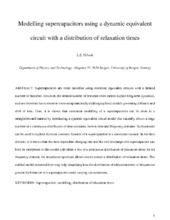Modelling supercapacitors using a dynamic equivalent circuit with a distribution of relaxation times
Peer reviewed, Journal article
Published version

Åpne
Permanent lenke
https://hdl.handle.net/1956/23619Utgivelsesdato
2019Metadata
Vis full innførselSamlinger
Originalversjon
https://doi.org/10.1016/j.est.2019.100912Sammendrag
Supercapacitors are often modelled using electrical equivalent circuits with a limited number of branches. However, the limited number of branches often cannot explain long-term dynamics, and one therefore has to resort to more computationally challenging basic models governing diffusion and drift of ions. Here, it is shown that consistent modelling of a supercapacitor can be done in a straightforward manner by introducing a dynamic equivalent circuit model that naturally allows a large number or a continuous distribution of time constants, both in time and frequency domains. Such a model can be used to explain the most common features of a supercapacitor in a consistent manner. In the time domain, it is shown that the time-dependent charging rate and the self-discharge of a supercapacitor can both be interpreted in this model with either a few or a continuous distribution of relaxation times. In the frequency domain, the impedance spectrum allows one to extract a distribution of relaxation times. The unified model presented here may help visualizing how the distribution of relaxation times or frequencies govern the behaviour of a supercapacitor under varying circumstances.
